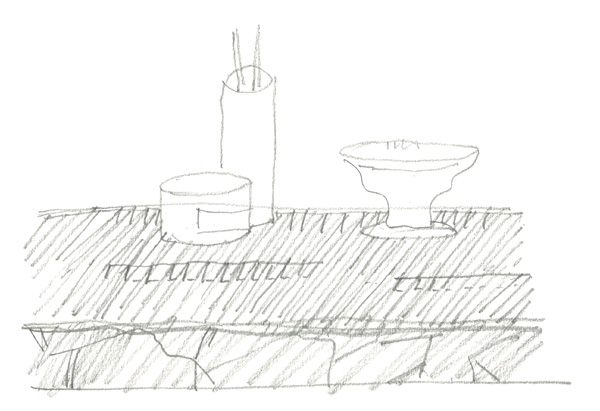Piano di posa
The object alibi from art to design

Giorgio Morandi, Natura morta, undated (1952), oil on canvas, 30,2x40,5 cm, Roma, private collection.
Giorgio Morandi’s paintings are based on elementary objects laid on neutral plans, in void and abstract places. These artifacts are often placed side by side with their geometrical synthesis, that in this painter’s works become lyrical and evocative motionless entities. The objects and their spaces, more mental than figurative, were the inspiration for a new collection of technical elements for the bathroom furnishing, made of marble and wood, and designed by Vittorio Longheu. Characterized by linear and absolute shapes, it is conceived to welcome objects and rituals of everyday contemporaneity.


Vittorio Longheu, graphic sketches for Piano di Posa collection, 2014.
This collection, called Piano di Posa (“base level”) in relation to the settings of Morandi’s still lifes, includes parallelepiped stone holders with wooden grids and valet stands forming a flexible modular system that the users can configure in different functional and formal compositions. The names as well, Grizzana and Campiaro, given to the basins and the shower plate respectively, pay tribute to Morandi’s favourite places.

Grizzana basin and Campiaro shower plate from Piano di Posa collection, created by Vittorio Longheu for Pibamarmi.

One of the possible configurations of Grizzana basin, seen from above.
Art transfers to design the essence of a meditation on the relationship between human beings and reality. This is originated by what can be called “l’alibi dell’oggetto” (“the object alibi”), as in the powerful title of an exhibition about Morandi and still lifes, curated by Marilena Pasquali at Fondazione Ragghianti, Lucca in 2007. In this conception real objects and their spatial contexts become supports and unique, unavoidable reasons to shape essential yet meaningful visions. They reveal the central role played by common objects and everyday phenomena.


Piano di Posa collection by Vittorio Longheu for Pibamarmi. Grizzana basin, details.
Longheu’s “base levels” don’t carry any symbolic value nor are fetishes linked to temporary trends, but they are pure, real objects, to be involved in actions or destined to a simple static vision. They indeed configure as domestic contexts with a double meaning: little scenarios with small props to use every day, but also well defined perceptive spheres to appreciate with the eyes. The grid becomes an articulated order where the users can put their preferred objects; the result is a project that, like Morandi’s paintings, tries to give the fragmentary and chaotic contemporaneity a consistent canon.
by Davide Turrini